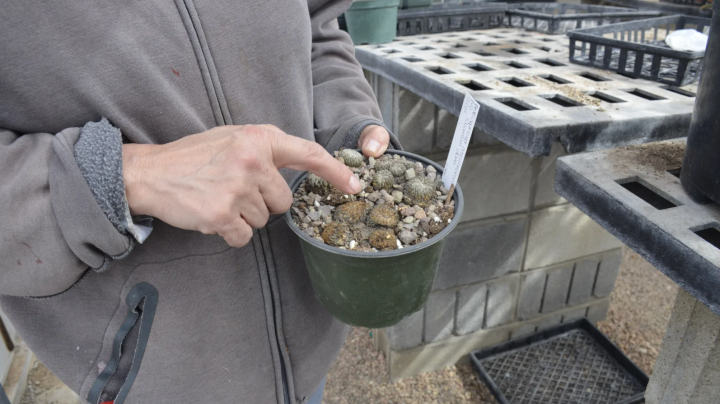
Cactus poachers are picking the Texas desert clean of rare species
Cactus poachers are picking the Texas desert clean of rare species

Michael Eason sat at his desk scrolling through cactus listings on eBay. Eason — a botanist in Alpine, Texas — was looking for something called the Ariocarpus fissuratus. Squat, furrowed and fleeced with a halo of white fuzz, this rare plant is found in West Texas’ Big Bend region. But for the right price, buyers can get one anywhere in the world.
Eason found several listings with high price tags and read them off: “$233 … $349 … $300 … so you can see it’s fairly lucrative for folks to sell wild-collected plants.” Eason said the Ariocarpus can go for even more overseas, upward of $1,000.
Eason specializes in the conservation of rare plants. Over the last 15 years, he said, he’s seen populations of cactus dwindle or even disappear completely as they fell victim to the booming underground market.
“It’s something in the back of the human brain that wants to have especially rare and unusual plants,” he said. “It’s much more of a treasure than just something they bought at a greenhouse somewhere.”
Currently valued in the tens of millions of dollars, the domestic cactus and succulent market is thriving. The market doesn’t stop at the local plant nursery, however.

Collectors who want especially rare specimens hit the lucrative online black market, where wild-collected cactuses go for exorbitant prices — sometimes in the thousands of dollars. Many of those cactuses come out of far West Texas, which the low level of surveillance and high level of unique cactus make an ideal location for poachers. This has a devastating effect on plant populations. Many species of cactus are threatened with extinction, and the main cause is illegal collection.
For years, the man in charge of cracking down on that activity in the Big Bend was Eric Jumper, the now-retired U.S. Fish and Wildlife Service agent who oversaw poaching cases here. He said cactus trafficking has run rampant in the Big Bend region since at least the 1970s, but it took a bit of convincing to get U.S. attorneys to take up the cases.
“Immigration issues, drug issues, all those things that are taking their time,” Jumper said. “We have to convince them. ‘Hey, you know, spend some time on this too.’”
Jumper said cactuses took over the last decade of his career. His department cracked down on multiple poaching operations, recovering illicit shipments from all over the Chihuahuan Desert. Despite the agency’s efforts, Jumper said, cactus poaching will only ramp up in the coming years, which he fears poses a threat to endangered species.
“The demand is so strong, I don’t think you can keep up with the supply.”
And when smuggled plants are intercepted, they often can’t be replanted successfully in the wild. So Fish and Wildlife sends them to greenhouses around the country where they can be cared for.
Karen Little manages one of those greenhouses at Sul Ross State University in Texas, which is filled with all kinds of recovered specimens from the Chihuahuan Desert. Some are squat and bristled, while others twist out of their pots, their furry stems arcing through the air.

In the last four years, the Sul Ross greenhouse has become a haven for confiscated black market cactus. They come by the truckload, Little said, with some deliveries numbering in the thousands. Most of the plants arrive in garbage bags — which doesn’t bode well for their survival.
“No cactus lover would ever put them in a garbage bag,” Little said. “They know they’re going to kill them that way.”
Because these cactuses can’t be repatriated back into the wild, Little does what she can, trying to salvage the plants and find them homes. However, in an effort to keep them close to their natural habitat, Little gives the plants to local cactus lovers, she said. They often send her photos in August and September, when they bloom.
“They’re gorgeous when they’re blooming,” Little said. “The first year I had those thousands of them, it was just overwhelmingly beautiful, but it was sad. I’d rather walk up a hill and see them blooming than in my greenhouse.”
But botanists say that as long as demand is strong in this illicit market, there may come a time when it will be easier to find certain cactuses online than in their natural habitat.
There’s a lot happening in the world. Through it all, Marketplace is here for you.
You rely on Marketplace to break down the world’s events and tell you how it affects you in a fact-based, approachable way. We rely on your financial support to keep making that possible.
Your donation today powers the independent journalism that you rely on. For just $5/month, you can help sustain Marketplace so we can keep reporting on the things that matter to you.

















